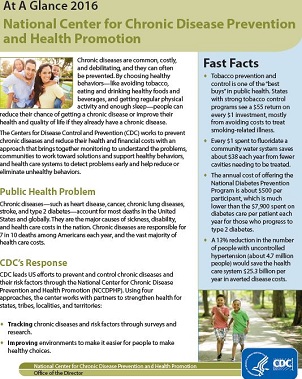National Center for Chronic Disease Prevention and Health Promotion
At A Glance 2016
Chronic diseases are common, costly, and debilitating, and they can often be prevented. By choosing healthy behaviors—like avoiding tobacco, eating and drinking healthy foods and beverages, and getting regular physical activity and enough sleep—people can reduce their chance of getting a chronic disease or improve their health and quality of life if they already have a chronic disease.
The Centers for Disease Control and Prevention (CDC) works to prevent chronic diseases and reduce their health and financial costs with an approach that brings together monitoring to understand the problems, communities to work toward solutions and support healthy behaviors, and health care systems to detect problems early and help reduce or eliminate unhealthy behaviors.
Public Health Problem
Chronic diseases—such as heart disease, cancer, chronic lung diseases, stroke, and type 2 diabetes—account for most deaths in the United States and globally. They are the major causes of sickness, disability, and health care costs in the nation. Chronic diseases are responsible for 7 in 10 deaths among Americans each year, and the vast majority of health care costs.
CDC’s Response
CDC leads US efforts to prevent and control chronic diseases and their risk factors through the National Center for Chronic Disease Prevention and Health Promotion (NCCDPHP). Using four approaches, the center works with partners to strengthen health for states, tribes, localities, and territories:
- Tracking chronic diseases and risk factors through surveys and research.
- Improving environments to make it easier for people to make healthy choices.
- Strengthening health care systems to deliver prevention services that keep people well and diagnose diseases early.
- Connecting clinical services to community programs that help people prevent and manage their chronic diseases and conditions.
See The Four Domains of Chronic Disease Prevention [PDF – 965 KB] for more information.
Fiscal Year 2016 Budget
NCCDPHP’s FY 2016 budget is $1.17 billion, including $339 million from the Prevention and Public Health Fund of the Affordable Care Act. Budget highlights include the following:
- Diabetes: $170 million to support diabetes prevention and control action. These investments help state, tribal, local, and territorial partners address primary prevention for people with prediabetes, such as through interventions that help people eat healthy foods and be more physically active.
- Heart Disease and Stroke: $160 million to continue to help states, tribes, localities and territories use heart disease and stroke prevention strategies that promote healthy lifestyles and behaviors, healthy environments and communities, and access to early and affordable detection and treatment.
- Racial and Ethnic Approaches to Community Health (REACH): $50.9 million to continue promoting effective, sustainable approaches to reducing health disparities. Activities include improving nutrition, increasing physical activity, reducing tobacco use, and expanding access to healthier environments and quality preventive services in health care and community settings.
- Tobacco Prevention and Control: $210 million, which continues the Tips From Former Smokers national education campaign and supports the National Tobacco Control Program (NTCP). Tips raises awareness about the health effects of tobacco use and encourages smokers to quit. NTCP funds all state health departments for tobacco use prevention and control action.
See more CDC budget information.
NCCDPHP Programs
- Cancer
- Diabetes
- Heart Disease and Stroke
- Nutrition, Physical Activity, and Obesity
- Oral Health
- Preventing Chronic Disease E-Journal
- Population Health
- Reproductive Health
- Smoking and Tobacco Use
- Tribal Resources
National Center for Chronic Disease Prevention and Health Promotion website
Related Materials
Fast Facts
- Tobacco prevention and control is one of the “best buys” in public health. States with strong tobacco control programs see a $55 return on every $1 investment, mostly from avoiding costs to treat smoking-related illness.
- Every $1 spent to fluoridate a community water system saves about $38 each year from fewer cavities needing to be treated.
- The annual cost of offering the National Diabetes Prevention Program is about $500 per participant, which is much lower than the $7,900 spent on diabetes care per patient each year for those who progress to type 2 diabetes.
- A 13% reduction in the number of people with uncontrolled hypertension (about 4.7 million people) would save the health care system $25.3 billion per year in averted disease costs.
Performance Highlights
| Since 2012, more than 5 million smokers have attempted to quit because of the Tips From Former Smokers national education campaign, and more than 400,000 of those have quit for good. | 
|
|
|
|
| Teen birth rates fell 46% from 2007 to 2015, dropping the national teen birth rate to an all-time low of 22.3 per 1,000 women aged 15 to 19. | |
|
|
|
| The percentage of adults with hypertension who have their blood pressure under control increased from 48.5% to 54% from 2008 to 2014. | 
|
|
|
|
| Since 2010, over 1,080 organizations and 11,000 coaches serving about 90,500 participants have implemented the National Diabetes Prevention Program. | 
|
|
|
|
|
The prevalence of obesity among children aged 2 to 5 years decreased significantly from 13.9% in 2003-2004 to 9.4% in 2013-2014. |

|
- Page last reviewed: June 27, 2017
- Page last updated: June 27, 2017
- Content source:



 ShareCompartir
ShareCompartir
